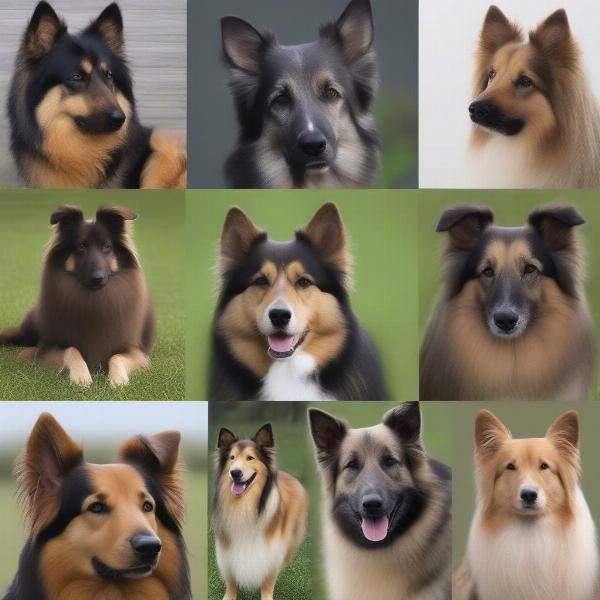Sable is a striking and often misunderstood dog coat color. It’s not a specific breed, but a color pattern that can appear in numerous breeds, from German Shepherds to Shetland Sheepdogs. This article will explore the genetics behind sable, its variations, and how to care for a dog with this beautiful coat.
The sable color is created by a specific gene combination that overlays black-tipped hairs onto a lighter base coat. This base can range from cream to a rich reddish-brown, creating a wide variety of sable shades. The black tipping can also vary in intensity, leading to some dogs appearing almost entirely black, while others have a more pronounced banded appearance. Because of this variability, it can sometimes be challenging to identify a truly sable dog, especially in puppies. What might appear as a solid color in a young pup can develop into the distinct sable pattern as the dog matures.
Decoding the Genetics of Sable Dog Color
The Agouti gene is the key player in the sable color expression. This gene controls the distribution of black pigment (eumelanin) and yellow/red pigment (phaeomelanin) in the hair shaft. In sable dogs, the Agouti gene creates a banded pattern, with each hair having alternating bands of light and dark color. The specific shade of the base coat is determined by other genes that influence pigment production.  Different shades of sable in various dog breeds.
Different shades of sable in various dog breeds.
Understanding the genetic complexities can be helpful for breeders interested in predicting litter outcomes. However, even with careful breeding, the sable pattern can be surprisingly unpredictable, adding to its unique appeal.
Caring for a Sable Dog’s Coat
While the sable color itself doesn’t require any specialized care, maintaining a healthy and vibrant coat is essential. Regular brushing helps remove dead hair and distribute natural oils, preventing matting and promoting shine. red dog coat
A balanced diet is also crucial for coat health. Nutrient deficiencies can lead to a dull coat, hair loss, and other skin problems. High-quality dog food rich in essential fatty acids and proteins can help keep your sable dog’s coat looking its best. ranch hound dog food reviews Bathing should be done only when necessary, as over-bathing can strip the coat of its natural oils.
Sable vs. Other Similar Coat Colors
Sable can sometimes be confused with other coat colors, like agouti or wolf sable. While they share some similarities, key differences exist. Agouti often refers to a more distinct banded pattern, whereas wolf sable typically describes a darker, more grizzled appearance. This differentiation, however, can be subtle and even vary within breeds.
What breeds commonly exhibit the sable color?
Many breeds can display the sable color, including German Shepherds, Shetland Sheepdogs, Collies, and Pomeranians. The specific shades and patterns can vary considerably between and even within breeds.
How can I tell if my puppy will be sable?
Determining a puppy’s final coat color can be challenging, especially with sable. While experienced breeders can sometimes make educated guesses based on parentage and puppy coat patterns, the true sable color often doesn’t fully develop until adulthood.
Does the sable color affect a dog’s health?
The sable color itself is simply a cosmetic trait and doesn’t affect a dog’s health directly. However, some genetic health conditions might be more prevalent in certain breeds that commonly exhibit sable coloring. Always research breed-specific health concerns when choosing a dog.
Conclusion
The sable dog color is a fascinating genetic phenomenon resulting in a stunning range of coat patterns. Understanding the genetics and variations of sable can help you appreciate this unique color even more. By providing proper care and nutrition, you can ensure that your sable dog’s coat remains healthy, vibrant, and a true testament to its unique beauty. [dog bone peanut butter](https://ilmdog.com/dog-bone-peanut butter.html)
FAQ
- What is the main gene responsible for the sable color? The Agouti gene is primarily responsible for the sable color pattern.
- Is sable a breed or a color? Sable is a coat color pattern, not a specific breed.
- How can I maintain my sable dog’s coat? Regular brushing, a balanced diet, and occasional bathing are key to maintaining a healthy sable coat.
- What are some breeds that commonly have sable coats? German Shepherds, Shetland Sheepdogs, Collies, and Pomeranians are just a few breeds that often display sable coloring.
- Does sable color affect a dog’s temperament? No, coat color does not influence a dog’s personality or behavior.
Expert Insight:
Dr. Emily Carter, DVM, “Sable coats are truly remarkable. The genetic complexity behind their patterns is fascinating, and the variation in shades is breathtaking. As a veterinarian, I always enjoy seeing the diverse expressions of this beautiful coat color.”
Professor Robert Davis, Canine Geneticist, “The Agouti gene is a fascinating area of study. Understanding how this gene interacts with other genetic factors to create the sable pattern is crucial for breeders and researchers alike.”
ILM Dog is a dedicated resource for all things canine. We offer expert advice on dog breeds, health, training, nutrition, grooming, and much more. Whether you’re a seasoned dog owner or just starting your journey with a furry companion, ILM Dog is here to guide you every step of the way. From dog buoyancy aid to understanding dog friendly wrapping paper, we cover all aspects of dog ownership. Contact us at [email protected] or +44 20-3965-8624 for personalized advice.